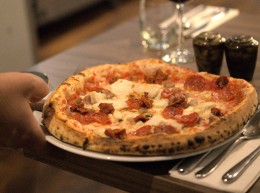A brief history on the introduction and rise in popularity of Italian food in the UK
- Mamma Lina's
- Aug 23, 2023
- 2 min read
If you love Italian food, you might wonder how this delicious cuisine made its way to the UK. In this blog post, we'll explore the history of Italian food in Britain, from the ancient Romans to the modern pizza chains.
The first Italian migrants to Britain were the **Romans**, who invaded in 55 BC and stayed for almost four centuries. They brought with them their culinary traditions, such as bread, cheese, wine, olive oil, and herbs. They also introduced new crops and animals, such as apples, pears, plums, cherries, cabbage, carrots, peas, beans, chickens, and rabbits. Some of these foods became staples of the British diet, while others were forgotten or replaced by later invaders .
The next wave of Italian migration occurred in the **Middle Ages**, when merchants and bankers from northern Italy settled in London and other major cities. They were known as **Lombards**, and they established themselves in finance and trade. They also influenced the British cuisine with their exotic spices, dried fruits, nuts, and sugar. One of their most famous contributions was **marzipan**, a sweet paste made of almonds and sugar that was used to decorate cakes and pastries .
The largest influx of Italian immigrants happened in the **late 19th and early 20th centuries**, when thousands of Italians fled poverty and political turmoil in their homeland. Many of them settled in industrial areas such as London, Bedford, Glasgow, Edinburgh, and South Wales. They worked in various sectors, such as brickmaking, coal mining, shipbuilding, and catering. They also brought with them their culinary skills and opened cafes, ice cream parlours, fish and chip shops, and restaurants. They introduced the British public to authentic Italian dishes such as pizza, pasta, risotto, lasagna, tiramisu, espresso, and gelato .
The popularity of Italian food in Britain grew even more in the **post-war era**, when the economy boomed and people had more disposable income and leisure time. The first package holidays to Europe started in the late 60s and made overseas travel affordable to all. This exposed the British palate to more tasty and diverse foods and ingredients from Italy and other Mediterranean countries . The demand for Italian food also increased with the arrival of more immigrants from Italy and other parts of Europe in the 50s and 60s.
Today, Italian food is one of the most popular and widely available cuisines in Britain. You can find Italian restaurants, cafes, delis, supermarkets, and takeaways in every town and city. You can also cook Italian dishes at home with ease thanks to the abundance of recipes, cookbooks, TV shows, and online resources. Whether you prefer a classic Margherita pizza or a gourmet truffle pasta, you can enjoy the flavours of Italy anytime you want.
Italian food has come a long way since the Roman invasion. It has enriched the British culture and cuisine with its diversity, quality, and simplicity. It has also inspired many British chefs and food writers to create their own versions of Italian dishes or to fuse them with other cuisines. Italian food is not just a foreign import; it is part of our national identity.
: https://en.wikipedia.org/wiki/Italian_cuisine
: https://www.trentfurniture.co.uk/news/blog/blogid-79/how-italians-shaped-british-eating-habits
: https://www.historic-uk.com/CultureUK/Food-in-Britain-in-the-1950s-1960s/
: https://www.bbc.co.uk/food/articles/italian_food








Comments